Adobo is a versatile dish enjoyed in various cultures, but what are the original ingredients that make it so delicious? Originating from prehistoric times, adobo has evolved and been influenced by different regions and cultures over the centuries. Let’s delve into the authentic and traditional adobo recipe, exploring its rich history, cultural significance, and flavorful ingredients.
- Adobo is a popular dish with a rich history that can be traced back to prehistoric times.
- The word “adobo” comes from the Spanish word “adobar,” meaning marinade.
- The original adobo recipe involves marinating raw protein in vinegar, spices, and aromatics.
- In Spain, adobo refers to marinating meat in vinegar, spices, and aromatics.
- The Caribbean adobo is a dry spice blend consisting of paprika, oregano, cumin, garlic powder, onion powder, and turmeric.
- Filipino adobo is considered the national dish of the Philippines and is made with vinegar, soy sauce, garlic, bay leaves, and black pepper.
- Adobo variations can be found in Mexico, Peru, Portugal, and other countries influenced by Spanish colonization.
Unveiling the Origins of Adobo
The word “adobo” originates from the Spanish word “adobar,” meaning marinade, which gives us a hint about the technique used in preparing adobo. This dish has a rich history that dates back to prehistoric times when vinegar was used as a natural preservative for meat.
As Spanish explorers traveled the world, they brought the adobo technique to their colonies, including the Caribbean and the Philippines. Each region has put its own unique spin on adobo, resulting in delicious variations that have become integral parts of their respective cuisines.
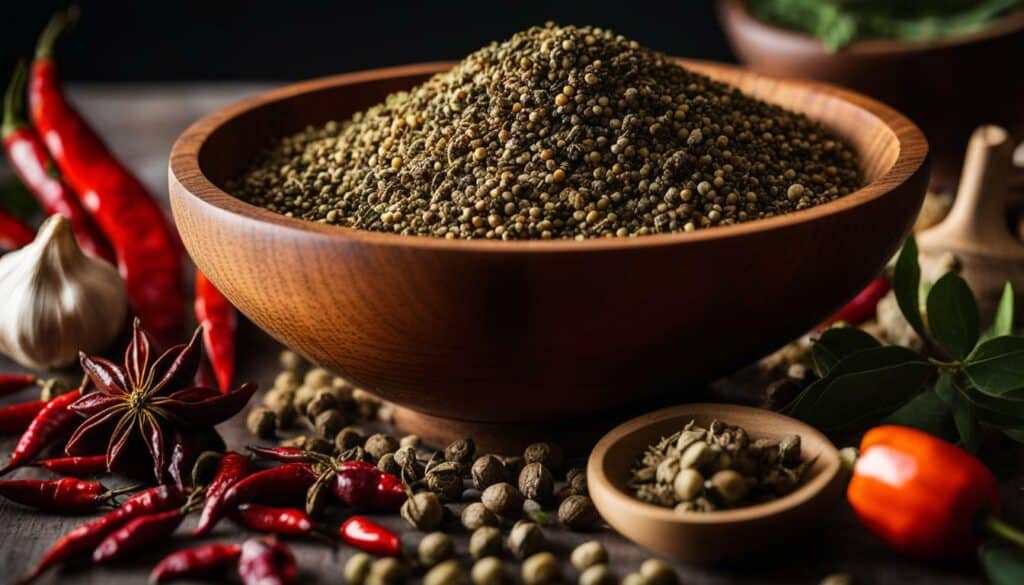
In Spain, adobo refers to marinating raw protein in vinegar, spices, and aromatics. The marinade infuses the meat with rich flavors and helps tenderize it, creating a succulent and flavorful dish.
In the Caribbean, adobo takes the form of a dry spice blend. The combination of paprika, oregano, cumin, garlic powder, onion powder, and turmeric delivers a burst of flavor to dishes, adding a Caribbean twist to the concept of adobo.
Origins of Adobo: A Journey of Flavors
| Region | Key Ingredients |
|---|---|
| Spain | Vinegar, spices, aromatics |
| Caribbean | Paprika, oregano, cumin, garlic powder, onion powder, turmeric |
| Philippines | Vinegar, soy sauce, garlic, bay leaves, black pepper |
In the Philippines, adobo is considered the national dish and holds a special place in Filipino cuisine. The Filipino version combines vinegar, soy sauce, garlic, bay leaves, and black pepper to create a unique blend of flavors that is simultaneously tangy, savory, and aromatic.
Adobo has also traveled to Mexico, Peru, Portugal, and other countries that were influenced by Spanish colonization. Each region has put its own twist on adobo, incorporating local ingredients and flavors to create exciting variations.
So, whether you prefer the Spanish, Caribbean, or Filipino version, adobo is a dish that transcends borders and represents the flavors and culinary heritage of different regions. Embrace the versatility of adobo and explore its various interpretations to discover the taste that speaks to your palate.
Traditional Spanish Adobo Recipe
Spanish adobo is all about marinating raw protein in a tangy blend of vinegar, spices, and aromatic ingredients. This centuries-old technique was brought to the Spanish colonies, including the Philippines and the Caribbean, where it evolved into different variations. If you’re a fan of bold, zesty flavors, then you’ll definitely want to try your hand at making this traditional Spanish adobo recipe.
To prepare the marinade, you’ll need a combination of vinegar, soy sauce, garlic, bay leaves, and black pepper. These ingredients come together to create a rich and tangy flavor profile that infuses the meat with deliciousness. Whether you’re using pork or chicken, the key is to let the protein soak in the marinade for at least a few hours, or overnight if you have the time. This allows the flavors to penetrate the meat, resulting in a tender and flavorful dish.
To start cooking, simply place the marinated protein in a pot along with the marinade and let it simmer until the meat is tender and the flavors have melded together. The slow cooking process allows the adobo to develop its signature depth of flavor. Once cooked, serve the adobo over steamed rice or with a side of vegetables for a complete and satisfying meal.
| Ingredients: | Instructions: |
|---|---|
| – Vinegar | 1. In a bowl, combine the vinegar, soy sauce, garlic, bay leaves, and black pepper to make the marinade. |
| – Soy sauce | 2. Place the raw protein in a resealable bag or container and pour the marinade over it. Make sure the meat is fully coated and marinate for at least 2 hours, or overnight in the refrigerator. |
| – Garlic | 3. When ready to cook, transfer the marinated protein and marinade to a pot and bring to a simmer over medium heat. |
| – Bay leaves | 4. Reduce the heat to low and let the adobo simmer for about 1 to 1.5 hours, or until the meat is tender and the flavors have melded together. |
| – Black pepper | 5. Serve the adobo hot over steamed rice or with your choice of accompaniments. |

Spanish adobo is a true culinary delight, with its bold flavors and tender meat. The tangy blend of vinegar, soy sauce, garlic, bay leaves, and black pepper creates an irresistible combination that will satisfy your taste buds. Whether you’re a fan of pork or chicken, the traditional Spanish adobo recipe is a must-try for anyone seeking a delicious and authentic dining experience.
So why not bring a touch of Spain to your kitchen with this classic adobo recipe? The marinade infuses the meat with vibrant flavors, making every bite a burst of deliciousness. Whether you’re cooking for yourself or hosting a dinner party, Spanish adobo is sure to impress your guests and leave them craving for more.
“Spanish adobo is a true culinary delight with its bold flavors and tender meat. The tangy blend of vinegar, soy sauce, garlic, bay leaves, and black pepper creates an irresistible combination that will satisfy your taste buds.”
So, the next time you’re in the mood for a mouthwatering meal, consider making the traditional Spanish adobo recipe. It’s a wonderful way to explore the rich history and flavors of this beloved dish. Whether you’re a fan of Spanish cuisine or simply looking to expand your culinary horizons, Spanish adobo is a must-have in your recipe repertoire.
Caribbean Adobo Spice Blend
In the Caribbean, adobo is a vibrant spice blend that brings a burst of flavor to dishes with its combination of paprika, oregano, cumin, garlic powder, onion powder, and turmeric. This unique blend of spices adds a delicious and aromatic touch to Caribbean cuisine, infusing dishes with a taste of the tropics.
Caribbean adobo is a versatile seasoning that can be used to marinate meats, vegetables, or even sprinkled over rice and beans for a flavorful twist. The combination of paprika, oregano, cumin, garlic powder, onion powder, and turmeric creates a balance of smoky, savory, and slightly spicy flavors that will transport you to the sunny shores of the Caribbean.
Caribbean Adobo Spice Blend Recipe
If you’re feeling adventurous and want to try your hand at making your own Caribbean adobo spice blend, here’s a simple recipe to get you started:
| Ingredient | Measurement |
|---|---|
| Paprika | 2 tablespoons |
| Oregano | 1 tablespoon |
| Cumin | 1 tablespoon |
| Garlic powder | 1 tablespoon |
| Onion powder | 1 tablespoon |
| Turmeric | 1 tablespoon |
Simply mix all the ingredients together in a bowl until well combined, and store in an airtight container for future use. This homemade Caribbean adobo spice blend will add a touch of the Caribbean to your culinary creations.
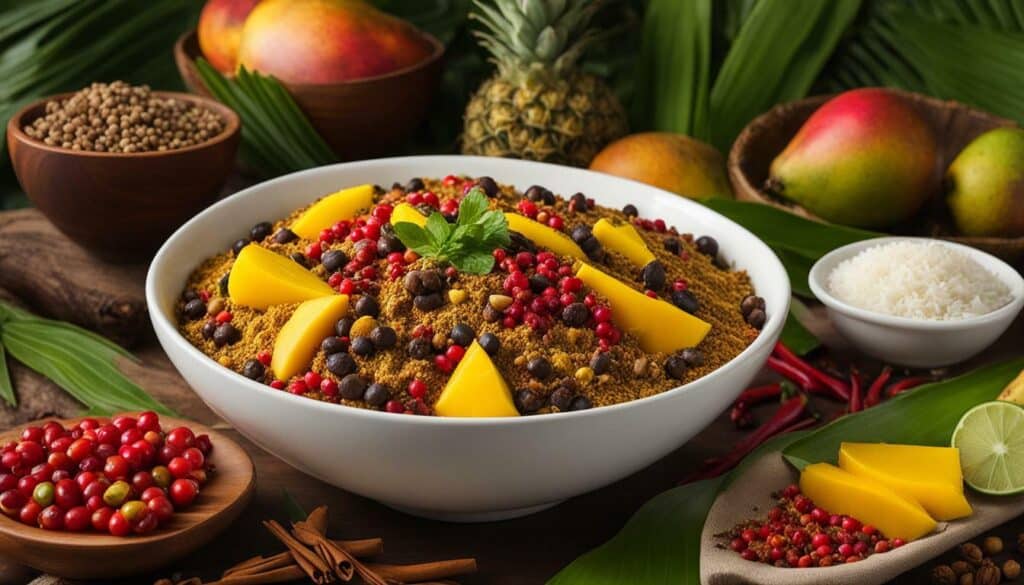 Remember, the beauty of adobo lies in its versatility and ability to adapt to different culinary traditions. Whether you’re adding a Caribbean twist to your dishes or exploring other variations, adobo is sure to delight your taste buds and transport you to a world of bold flavors. So, why not spice up your cooking with a little taste of the Caribbean?
Remember, the beauty of adobo lies in its versatility and ability to adapt to different culinary traditions. Whether you’re adding a Caribbean twist to your dishes or exploring other variations, adobo is sure to delight your taste buds and transport you to a world of bold flavors. So, why not spice up your cooking with a little taste of the Caribbean?
Filipino adobo is a beloved dish made with the essential ingredients of vinegar, soy sauce, garlic, bay leaves, and black pepper. These ingredients come together to create a savory and tangy flavor profile that is unique to Filipino cuisine. Adobo is a dish that has been passed down through generations and holds a special place in Filipino culture.
The use of vinegar and soy sauce as the base of the marinade is what sets Filipino adobo apart from other variations. The acidity of the vinegar helps tenderize the meat while adding a tangy flavor, while the soy sauce adds a rich umami taste. Garlic, bay leaves, and black pepper are added to enhance the overall taste and aroma of the dish.
When cooking traditional Filipino adobo, it is important to use the right proportions of these key ingredients to achieve the perfect balance of flavors. The marinade is typically made by combining equal parts vinegar and soy sauce, along with minced garlic, crushed black pepper, and a few bay leaves. The meat, usually chicken or pork, is then marinated in this mixture for several hours or overnight to allow the flavors to penetrate the meat.
| Ingredient | Measurement |
|---|---|
| Vinegar | 1/2 cup |
| Soy sauce | 1/2 cup |
| Garlic | 4 cloves, minced |
| Black pepper | 1 teaspoon, crushed |
| Bay leaves | 2 leaves |
Once marinated, the meat is then simmered in the marinade until it becomes tender and the flavors have melded together. The result is a deliciously savory dish that pairs well with steamed rice, making it a staple in Filipino households and celebrations.
So, if you’re looking to recreate the taste of the Philippines in your own kitchen, gather these essential ingredients and get ready to experience the flavors of authentic Filipino adobo. Whether you’re a fan of chicken adobo, pork adobo, or even adobo made with other proteins like beef or tofu, the key ingredients of vinegar, soy sauce, garlic, bay leaves, and black pepper will ensure that your adobo is full of rich and satisfying flavors.
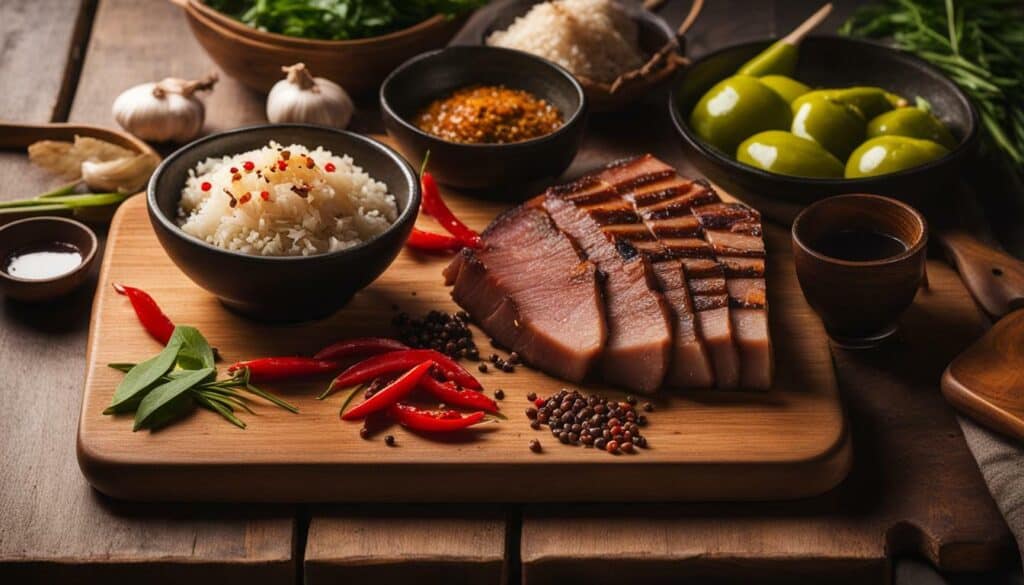
- “Filipino Adobo.” Panlasang Pinoy, https://panlasangpinoy.com/filipino-adobo/.
- “Chicken Adobo.” Kawaling Pinoy, https://www.kawalingpinoy.com/chicken-adobo/.
- “Pork Adobo.” Foxy Folksy, https://www.foxyfolksy.com/pork-adobo/.
Adobo Variations Around the World
Adobo has spread its culinary influence around the world, leading to variations in countries like Mexico, Peru, Portugal, and beyond. Each region has embraced adobo and added its own unique twist, resulting in a diverse range of flavors and ingredients.
In Mexico, adobo is characterized by its rich and smoky flavors. The sauce is made from a blend of dried chili peppers, garlic, vinegar, and spices. It is commonly used as a marinade for meats like chicken, pork, and beef, infusing them with a bold and tangy taste.
Peruvian adobo, known as “adobo de chancho,” features pork marinated in a mixture of vinegar, garlic, cumin, and other spices. The meat is then roasted or fried, creating a crispy exterior and tender interior. This savory dish is often served with rice, potatoes, and aji sauce for a burst of flavor.
In Portugal, adobo is known as “adubar” and refers to a technique of marinating fish or meat in a vinegar-based sauce. The traditional Portuguese adobo sauce consists of vinegar, wine, garlic, bay leaves, and spices. It is used to marinate various proteins, adding depth and tanginess to the dishes.
Adobo Variations Around the World
| Country | Variation | Main Ingredients |
|---|---|---|
| Mexico | Smoky | Dried chili peppers, garlic, vinegar, spices |
| Peru | Adobo de chancho | Pork, vinegar, garlic, cumin, spices |
| Portugal | Adubar | Fish or meat, vinegar, wine, garlic, bay leaves, spices |
These are just a few examples of the diverse adobo variations found around the world. Each country adds its own unique blend of spices, aromatics, and cooking techniques, resulting in a wide range of flavors and textures. Whether you prefer the smoky notes of Mexican adobo or the tanginess of Peruvian adobo, there is a variation to suit every taste bud.

Adobo goes beyond being just a delicious dish; it holds cultural significance and has become a staple in many kitchens around the globe. This flavorful and versatile dish has a fascinating history that has been shaped by different cultures and regions. From its origins in prehistoric times to its adaptation in various countries influenced by Spanish colonization, adobo has evolved while retaining its essence.
The word “adobo” itself comes from the Spanish word “adobar,” which means marinade. In Spain, adobo refers to marinating raw protein in vinegar, spices, and aromatics. This technique not only enhances the flavor but also helps in preserving the meat. The Spanish brought this marinade technique to their colonies, including the Caribbean and the Philippines, where adobo took on different forms.
Spanish Adobo Recipe
In Spain, adobo is traditionally made by marinating meat, such as pork or chicken, in a mixture of vinegar, garlic, oregano, black pepper, and other spices. This marinade infuses the meat with intense flavors and tenderizes it, resulting in a mouthwatering dish.
| Ingredients: | Instructions: |
|---|---|
| – Protein (pork or chicken) | 1. Cut the meat into equal-sized pieces. |
| – Vinegar | 2. In a bowl, combine vinegar, garlic, oregano, black pepper, and other desired spices. |
| – Garlic | 3. Add the meat to the marinade and refrigerate for at least 1 hour, or preferably overnight. |
| – Oregano | 4. Heat a pan with oil and cook the marinated meat until browned and cooked through. |
| – Black Pepper | 5. Serve the Spanish adobo with rice or bread and enjoy! |
Adobo has also found its way to the Caribbean, where it takes the form of a dry spice blend. The Caribbean adobo spice blend typically consists of paprika, oregano, cumin, garlic powder, onion powder, and turmeric. This aromatic blend is used to season meats, seafood, and vegetables, adding a burst of flavor to Caribbean dishes.
Filipino adobo, on the other hand, is renowned as the national dish of the Philippines. It is prepared by marinating meat in a mixture of vinegar, soy sauce, garlic, bay leaves, and black pepper. The combination of these ingredients creates a savory and tangy flavor that is loved by many. Filipino adobo can be made with various proteins, such as pork, chicken, or even tofu, making it a versatile dish for different dietary preferences.
Adobo variations can also be found in other countries influenced by Spanish colonization, including Mexico, Peru, and Portugal. Each region adds its own unique twist to the dish, using local ingredients and flavors.
Overall, adobo represents tradition, culture, and the flavors of a particular region. Its culinary significance is undeniable, as it continues to delight taste buds and bring people together. So why not embrace the rich history and versatility of adobo and elevate your cooking skills with this delicious dish?
Exploring Adobo’s Evolution
Adobo has evolved and adapted, incorporating new ingredients and cooking techniques while retaining its essence as a flavorful dish. Over the years, this beloved dish has traveled around the world and embraced different flavors and cultural influences. From its origins in prehistoric times to its Spanish colonization, adobo has become a staple in many households, with each region adding its own unique twist.
In Spain, adobo refers to marinating raw protein in vinegar, spices, and aromatics. The Spanish brought this culinary technique to their colonies, including the Caribbean and the Philippines. In the Caribbean, adobo takes the form of a dry spice blend consisting of paprika, oregano, cumin, garlic powder, onion powder, and turmeric. This aromatic blend adds a burst of flavor to dishes and reflects the vibrant spices of the region.
Adobo has become a versatile dish, adapting to different tastes and preferences in various countries influenced by Spanish colonization. From Mexico to Peru to Portugal, each region has its own interpretation of adobo, incorporating local ingredients and cooking methods.
In the Philippines, adobo is considered the national dish and holds deep cultural significance. The authentic Filipino adobo is made with vinegar, soy sauce, garlic, bay leaves, and black pepper, resulting in a savory and tangy flavor profile. Filipino adobo is known for its versatility, as it can be made with various proteins such as chicken, pork, or even vegetables.
As adobo continues to evolve, so does our appreciation for its rich history and diverse variations. Whether you’re enjoying a traditional Spanish adobo, savoring the Caribbean spice blend, or indulging in the flavors of Filipino adobo, the essence of this dish remains constant – a delicious and timeless culinary experience.
Unlocking the Secrets of Adobo Cooking
Discover the secrets of adobo cooking that will elevate your culinary skills and help you prepare the perfect adobo dish every time. Adobo is a versatile dish that can be made with various proteins and flavorings, allowing you to create a unique and personalized version that suits your taste preferences. Whether you are a beginner or an experienced cook, these tips and tricks will take your adobo game to the next level.
One of the key elements in adobo is the marinade, which infuses the meat with a rich and flavorful taste. The traditional adobo marinade typically consists of vinegar, soy sauce, garlic, bay leaves, and black pepper. However, you can experiment with different spices and herbs to create your own signature marinade. For example, you can add a pinch of paprika for a smoky undertone or a dash of chili flakes for a spicy kick.
Cooking time and method are also crucial factors in achieving the perfect adobo. Some recipes call for simmering the meat in the marinade for a longer period to allow the flavors to meld together, while others prefer a shorter cooking time for a more tender and juicy result. The choice is yours and depends on your personal taste. You can cook adobo on the stovetop, in a slow cooker, or even in the oven, adapting the cooking method to your convenience and preference.
Adobo is a dish that gets better with time, so don’t be afraid to make a batch in advance and let it marinate overnight in the refrigerator. This allows the flavors to develop and intensify, resulting in a more robust and delicious dish. When it comes to serving adobo, you can enjoy it with steamed rice, mashed potatoes, or even in tacos or sandwiches for a twist on traditional presentation. The possibilities are endless!
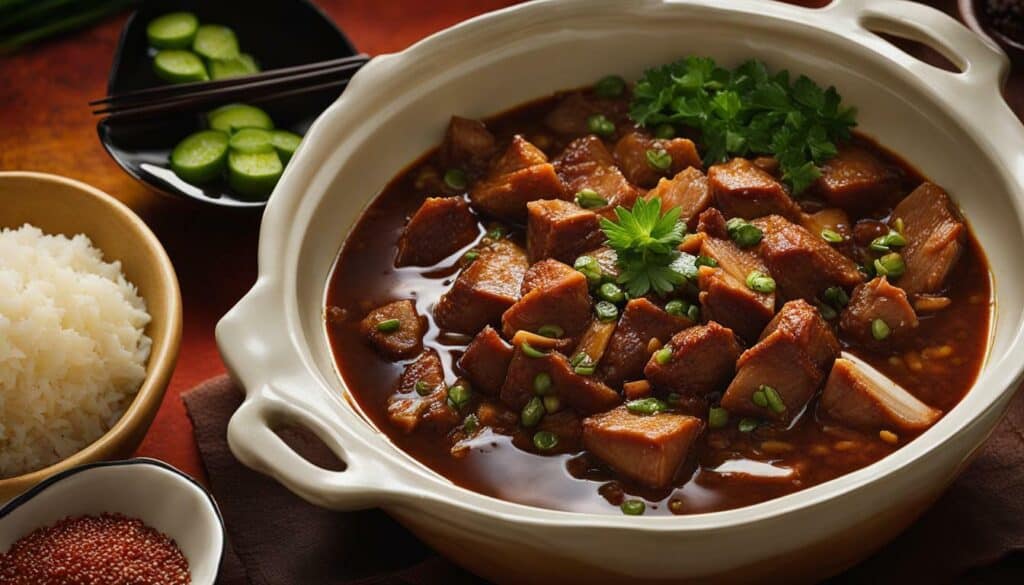
| Ingredients | Measurements |
|---|---|
| Vinegar | 1/2 cup |
| Soy Sauce | 1/2 cup |
| Garlic | 4 cloves, minced |
| Bay Leaves | 2 leaves |
| Black Pepper | 1/2 teaspoon |
“Adobo is not just a dish; it represents tradition, culture, and the flavors of a particular region.” – Unknown
So, whether you’re cooking traditional Filipino adobo, experimenting with different adobo variations, or creating your own unique twist, these secrets of adobo cooking will guide you to culinary success. Enjoy the rich flavors, the history, and the cultural significance that adobo brings to your table.
Embracing Adobo’s Versatility
Adobo’s versatility allows you to customize the dish with different proteins and flavorings, making it a truly unique culinary experience. Whether you prefer the traditional Filipino adobo with tender pork or savory chicken, or you want to explore the flavors of Spanish or Caribbean adobo, there is a recipe out there that will satisfy your taste buds.
The beauty of adobo lies in its ability to adapt and incorporate a wide range of ingredients. You can experiment with various proteins like beef, lamb, or even tofu to create a personalized adobo dish that suits your dietary preferences. The combination of tangy vinegar, rich soy sauce, fragrant garlic, and aromatic spices gives adobo its signature flavor, while the cooking process infuses the meat with tenderness and depth.
One of the best things about adobo is its simplicity. With just a handful of ingredients, you can create a mouthwatering dish that will impress your family and friends. The key is finding the right balance of flavors, whether you prefer a tangier adobo with more vinegar or a sweeter adobo with a touch of sugar. Don’t be afraid to experiment and adjust the seasoning to suit your own taste.
To fully embrace adobo’s versatility, consider adding your own twist to the classic recipe. You can introduce additional spices like smoked paprika, chipotle powder, or even coconut milk to add complexity and depth to your adobo dish. The possibilities are endless, and the only limit is your imagination!
Adobo – A Taste of Tradition
Adobo is more than just a dish; it embodies tradition, culture, and the rich culinary heritage of its region. This iconic Filipino dish has captured the hearts and taste buds of people around the world, becoming a staple in Filipino households and a symbol of Filipino identity. The authentic adobo recipe has been passed down through generations, preserving the unique flavors that make it truly special.
At the heart of the traditional adobo recipe are the authentic adobo ingredients that give this dish its distinct taste. Vinegar, soy sauce, garlic, bay leaves, and black pepper come together to create a harmonious blend of flavors that is both tangy and savory. The combination of these ingredients, along with the slow cooking process, results in tender meat with a rich and flavorful sauce that is perfect for spooning over steamed rice.
To fully appreciate the culinary significance of adobo, it’s important to understand its historical roots. The word “adobo” comes from the Spanish word “adobar,” which means marinade. The original adobo recipe can be traced back to prehistoric times when vinegar was used as a natural preservative for meat. The Spanish colonizers later brought the adobo technique to their colonies, including the Philippines, where it took on a distinct Filipino twist. Today, Filipino adobo is considered the national dish of the Philippines and is prepared with various proteins, such as chicken, pork, or even vegetables.
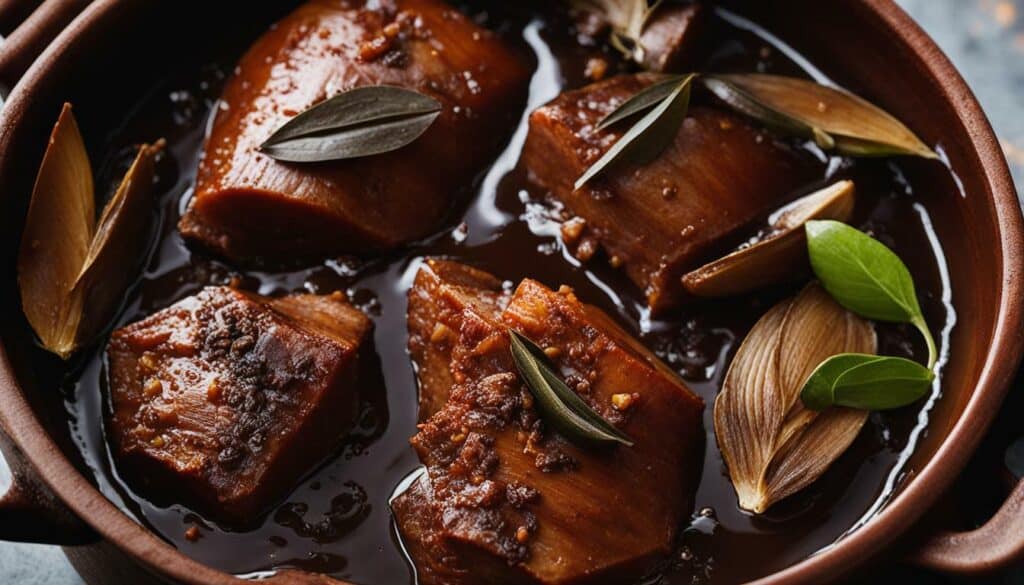
Adobo’s versatility extends beyond the traditional recipe. Different regions and cultures have put their own spin on adobo, resulting in unique variations. For example, in the Caribbean, adobo is a dry spice blend that adds a burst of flavor to dishes. Paprika, oregano, cumin, garlic powder, onion powder, and turmeric come together to create a vibrant seasoning that can be used on meats, vegetables, or even as a rub for grilling.
Adobo has truly stood the test of time, evolving and adapting to different tastes and preferences. Its ability to bring people together, celebrate cultural heritage, and showcase the diversity of flavors is what makes adobo a timeless classic. So, why not embrace adobo in your own kitchen and experience the taste of tradition for yourself? Try out an authentic adobo recipe, explore the variations, and let this flavorful dish transport you to the heart of Filipino cuisine.
Elevate Your Cooking with Adobo
With your newfound knowledge of adobo’s original ingredients and cultural significance, it’s time to dive into the kitchen and bring the flavors of this beloved dish to life.
Adobo is a versatile dish that can be customized to suit your preferences and dietary needs. Whether you prefer the traditional Spanish recipe, the vibrant Caribbean spice blend, or the authentic Filipino version, adobo is sure to delight your taste buds.
To prepare the traditional Spanish adobo, marinate your choice of protein in vinegar, spices, and aromatics. Let the flavors meld together for a few hours or overnight, then cook it to perfection. The result is a tender and flavorful dish that will transport you to the sunny streets of Spain.
If you’re in the mood for a Caribbean-inspired twist, try using the adobo spice blend. Combine paprika, oregano, cumin, garlic powder, onion powder, and turmeric to create a fragrant and bold seasoning. Sprinkle it on meats, vegetables, or even snacks for an extra punch of flavor.
For an authentic taste of the Philippines, prepare Filipino adobo using vinegar, soy sauce, garlic, bay leaves, and black pepper. The combination of tangy vinegar and savory soy sauce creates a balance of flavors that is truly unique. Whether you choose chicken, pork, or even tofu as your protein, Filipino adobo is sure to satisfy.
Don’t be afraid to experiment with adobo and make it your own. Try different proteins, spices, or even add your favorite ingredients to elevate the dish to new heights. Adobo is a culinary journey that allows you to explore the diverse flavors and traditions from around the world.
So, gather your ingredients, embrace the flavors of adobo, and let your kitchen be filled with the enticing aroma of this timeless dish. Get ready to elevate your cooking skills and impress your family and friends with the deliciousness of adobo!
FAQ
Q: What are the original ingredients in adobo?
A: The original ingredients in adobo vary depending on the region and culture. However, the basic ingredients include vinegar, soy sauce, garlic, bay leaves, and black pepper.
Q: Where does the word “adobo” come from?
A: The word “adobo” comes from the Spanish word “adobar,” which means marinade.
Q: What is the traditional Spanish adobo recipe?
A: The traditional Spanish adobo recipe involves marinating raw protein in vinegar, spices, and aromatics.
Q: What is the Caribbean adobo spice blend made of?
A: The Caribbean adobo spice blend consists of paprika, oregano, cumin, garlic powder, onion powder, and turmeric.
Q: What are the authentic ingredients used in Filipino adobo?
A: The authentic ingredients used in Filipino adobo include vinegar, soy sauce, garlic, bay leaves, and black pepper.
Q: Are there different adobo variations around the world?
A: Yes, adobo variations can be found in Mexico, Peru, Portugal, and other countries that were influenced by Spanish colonization.
Q: What is the culinary significance of adobo?
A: Adobo holds a special place in the culinary world and has become a staple in many households due to its rich flavors and cultural significance.
Q: How has adobo evolved over time?
A: Adobo has evolved and adapted to different tastes and preferences, embracing new ingredients and cooking techniques while still maintaining its essence.
Q: What are some tips for cooking adobo?
A: Some tips for cooking adobo include marinating the protein for a sufficient amount of time, experimenting with different ingredients and flavors, and adjusting the cooking method to achieve the desired texture.
Q: Can adobo be made with different proteins?
A: Yes, adobo can be made with various proteins such as pork, chicken, beef, or even fish, allowing for versatility in creating unique adobo dishes.
Q: What is the cultural significance of adobo?
A: Adobo represents tradition, culture, and the flavors of a particular region, creating a connection to heritage and creating unforgettable taste experiences.
Q: How can I elevate my cooking with adobo?
A: By exploring different adobo variations and experimenting with the authentic ingredients, you can elevate your cooking skills and create delicious and flavorsome adobo dishes.
Q: Where can I find an authentic adobo recipe?
A: An authentic adobo recipe can be found in various cookbooks, online recipe platforms, or by asking individuals from the respective culture who have experience in making adobo.
Can Adobo Ingredients Be Used in Detox Drinks?
Can Adobo Ingredients Be Used in Detox Drinks? Adobo, a popular Filipino dish, typically uses soy sauce, vinegar, garlic, and other flavorful spices. While these ingredients may not be the traditional choice for detox drinks, their combination can add unique and tangy flavors to your beverage. However, it’s essential to note that the best ingredients for detox drinks usually consist of fresh fruits, vegetables, and herbs, chosen for their cleansing properties.


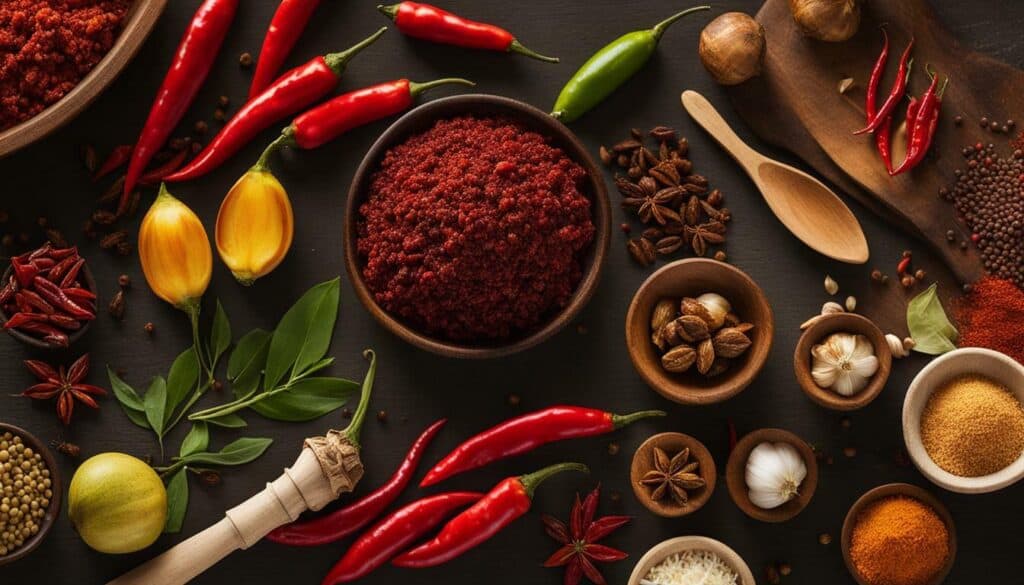





Leave a Reply